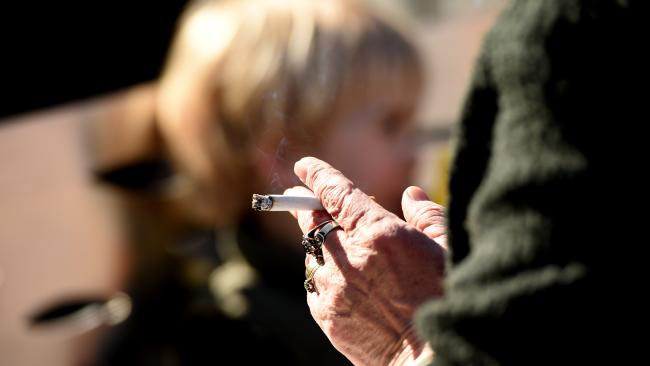Annual deaths from tobacco-related diseases are greater than from alcohol and illicit drugs combined.
ADAM CREIGHTON
August 14, 2017
The Australian
The number of smokers in Australia has increased for the first time since anti-smoking campaigns ramped up a generation ago, casting doubt on the effectiveness of further taxes on cigarettes.
An unexpected standstill in the national smoking rate since 2013, combined with rapid population growth, has pushed up the number of regular smokers by more than 21,000 to 2.4 million according to Colin Mendelsohn, an expert in public health at the University of New South Wales, who says Australia’s “punitive and coercive” policies to curb smoking have “run out of steam”.
“For the first time ever, there has been no statistically significant reduction in the smoking rate, and an increase in the number of smokers in Australia,” he told The Australian, noting the nation’s smoking rate was now higher than in the US for the first time in a decade. “This is despite plain packaging and the most expensive cigarette prices in the world.”
The analysis, based on the triennial survey conducted independently by the Australian Institute of Health and Welfare, found the number of smokers fell by 317,000 between 2010 and 2013 but rose 21,100 in the three years to 2016. “That’s the first time that’s ever happened. The rates have always dropped significantly every time,” Dr Mendelsohn said, pointing out that the fall in the daily smoking rate for over-18s of 0.5 per cent to 12.8 per cent in 2016 was statistically insignificant.
He said plain packaging and tax increases had worked better for younger than older smokers, noting regular smoking rates for 12 to 17 years old had halved to 1.5 per cent over the past three years. “But we’re left with established, older smokers who can’t or won’t quit. The strategy of higher prices isn’t working for them,” he said.
A standard pack of Marlboro cigarettes averages $25.10 in Australia according to price comparison website Numbeo, compared with $14.80 in Britain, $8.50 in the US and $1.90 in Indonesia. “There are law of diminishing returns to price increases; a lot of smokers are digging their heels in,” Dr Mendelsohn said, suggesting high prices had fuelled a black market.
The government’s world-beating tobacco excise haul, $11.6 billion this year (or $4950 a year per regular smoker), is on track to rise 31 per cent over the three years to 2021 owing to scheduled increases in excise of 12.5 per cent every year until then.
Alex Wodak, director of the Australian Drug Law Reform Foundation, endorsed Dr Mendelsohn’s analysis and concerns. “Australia is doing everything right in terms of tobacco control, but one key difference with the UK and USA, where smoking rates have dropped, is our hostility to e-cigarettes,” he added.
“I do wonder about the law of diminishing returns with higher prices and whether that’s starting to apply here,” Dr Wodak said, stressing he was a supporter of plain-packaging laws, introduced in 2011. “You wonder about poor people being hit with higher taxes when electricity prices are rising.”
Annual deaths from tobacco-related diseases, about 15,000 in recent years, are greater than from alcohol and illicit drugs combined.
Daily smokers as a share of the Australian population aged over 14 has fallen from 25 per cent in the early 1990s — when federal and state government launched a series of National Tobacco Campaigns to discourage smoking — to 12.2 per cent in 2016, while the share of casual smokers has halved to 5.2 per cent.
The latest smoking rates for over-18s in the US and Britain, 15.1 and 15.8 per cent respectively, are similar to or lower than in Australia, which has historically had significantly lower smoking rates.
Subscribe to our free mailing list and always be the first to receive the latest news and updates.

